Big Ears Festival 2024: An exercise in Chaos
Highlights included Laurie Anderson, Nik Bärtsch’s Ronin, Medeski-Russo-Ribot, Hermanos Guitierez.
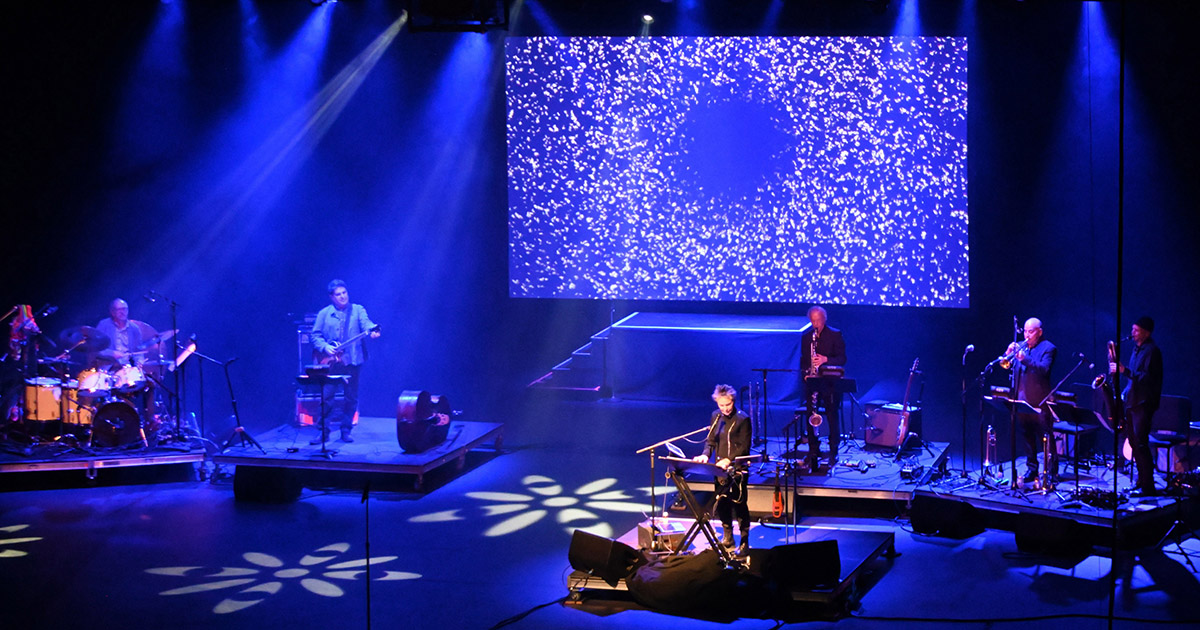
Laurie Anderson, with Sexmob, at Big Ears 2024
JOHN DILIBERTO”S PATH THROUGH BIG EARS FESTIVAL 2024
The Big Ears Festival itself was not chaotic. It is a mostly well-oiled machine, with only a few hiccups, like the 40 minute late start to Roger Eno, and hour-long delay for John Paul Jones & Thurston Moore.
No, the chaos was my journey through the festival. If you read my earlier article, A Path Through Big Ears Festival 2024, just forget that. My well-laid plans were quickly a shambles. I saw 20 performances across three and a half days. It should’ve been about 25 but . . . at Big Ears, interviews, life, and changes-of-heart happen.
The only thing that went according to plan was my first show with Henry Threadgill’s Very Very Circus. Threadgill did not perform. This was one of several repertory groups playing his music. And although guitarist Brandon Ross was the only musician I knew, they were very very good. It took them a while to get going, which makes sense with a line-up of two Tubas and two trombones. Those instruments are often used in circus music, which gives the band its name. The tubas especially give a slow drag to anything they are in, no matter how fast the rhythm and melody are. The first few songs sounded polished, but perfunctory.
But about half-way through, the two tubas broke off in a section of long, deep drones and overtones. It was like hearing the ocean in slow motion, and then the ensemble just took off. The two guitarists, Brandon Ross and Miles Okazaki, swapped between fairly minimal, unprocessed guitar to screaming fuzz tones and lightning runs. Noah Becker got off some incisive saxophone runs. Curiously, the set started with two trombonists, but one of them, Ron Caswell, disappeared, leaving the other trombonist, who was not listed, on his own. It was a nice, rousing start although it seemed to lack a center.
Threadgill himself appeared in the band Henry Threadgill’s Zoid. This band is something of an academic exercise and as that implies, it was soulless, sounding more like jazz spun through early 20th century 12-tone strategies. Liberty Ellman, playing an acoustic guitar with an electric pick-up, took a lot of the solo space, but his clean tone only accentuated the relative sterility of the performance. Threadgill himself seemed distant, his solos lacking any passion. This group was more of a composition exercise than jazz performance

Henry Threadgill / Vijay Iyer / Dafnis Prieto at Big Ears Festival 2024 Pic: Jeff Towne
But the saxophonist redeemed himself two days later in a trio with pianist Vijay Iyer and drummer Dafnis Prieto. That set opened calmly enough with a meditative bass flute solo, but then Iyer kicked in with a furious modal vamp and Threadgill unleashed an alto solo to match. Prieto is a monster drummer, playing with piston rapidity and precision, often staying at the high end of his kit. A Cuban-influenced track highlighted the drummer’s roots as well as his command of multi-faceted rhythms. There was so much more energy and exuberance coming from Iyer and Prieto that Threadgill did all he could to ride their flowing grooves.
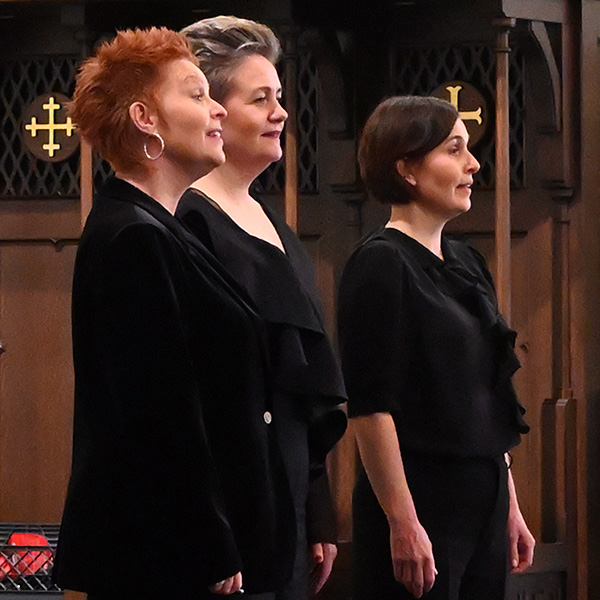
Trio Mediaeval at Big Ears Festival Pic: Jeff Towne
On Saturday I went to church, seeing three concerts that took full advantage of the resonance of St. John’s Episcopal Cathedral. The first was Trio Mediaeval. They opened with “Kyrie,” and as the melody passed seamlessly from one voice to another, the mastery of these three woman was evident. Singing without amplification, their voices filled the reverberant space so it seemed like music was coming from the entire room and not their mouths. They would move from complex melismatic polyphony into deep close harmony.
The trio mixed Gregorian chant, hymns of Abbess Hildegard von Bingen and contemporary compositions. It wasn’t all smooth listening as

Hatis Noit at Big Ears Festival 2024 Pic J.Diliberto
Anna Maria Friman unleashed a banshee wail on one piece. On a solo hymn, Jorunn Lovise Husan’s voice sounded like more than one person and on another piece, the group engaged in harmonic singing. That was when you knew it was a modern composition.
When I interviewed the trio, I asked them if they thought of their music as transcendent. Despite having a great command of English, they are Norwegian, and they didn’t understand the word. Their performance was the definition.
An hour or so later, The Cathedral was commanded by Hatis Noit, a Japanese vocalist who does live looping. Dressed in a flowing white gown, she had 6” long red feathers protruding from either side of her nose. She engaged fully in the theatrical aspects of her music as she unleashed multi-cultural hymns and laments, sounding at times operatic, Bulgarian, Tibetan, Persian and Native American. She owes an obvious debt to Meredith Monk, who she acknowledged as a major influence, but you could also cite Lisa Gerrard and Joan La Barbara. She moved from ASMR whispers, to chirping animal sounds, to full-throated operatic diva vocals. Drawing much of the material from her album, Aura (Erased Tapes) it was an entrancing performance.
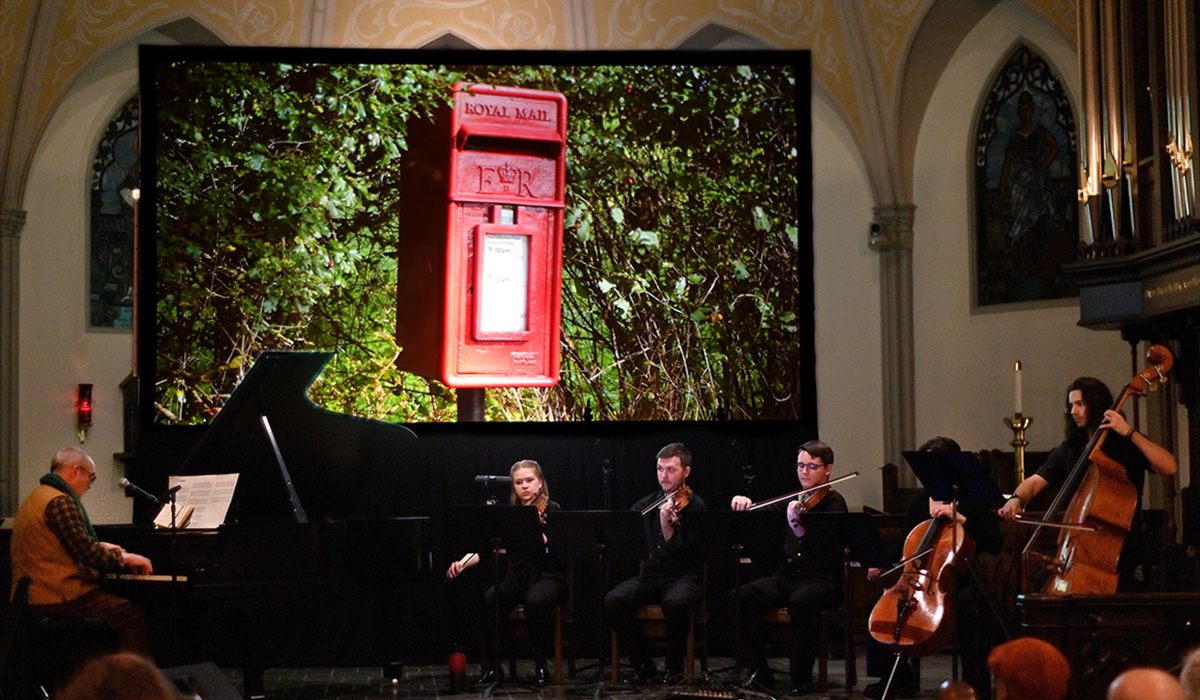
Roger Eno at Big Ears Festival Pic: Jeff Towne
All of these performances elicited deep listening, and the same could be said for Roger Eno’s concert that night. He’s moved in a more neo-classical mode over his last two albums and he brought that to Big Ears, with a string quintet cobbled together from local college students. There were a few glitches, including a 40-minute delay to the start, a rarity at Big Ears.
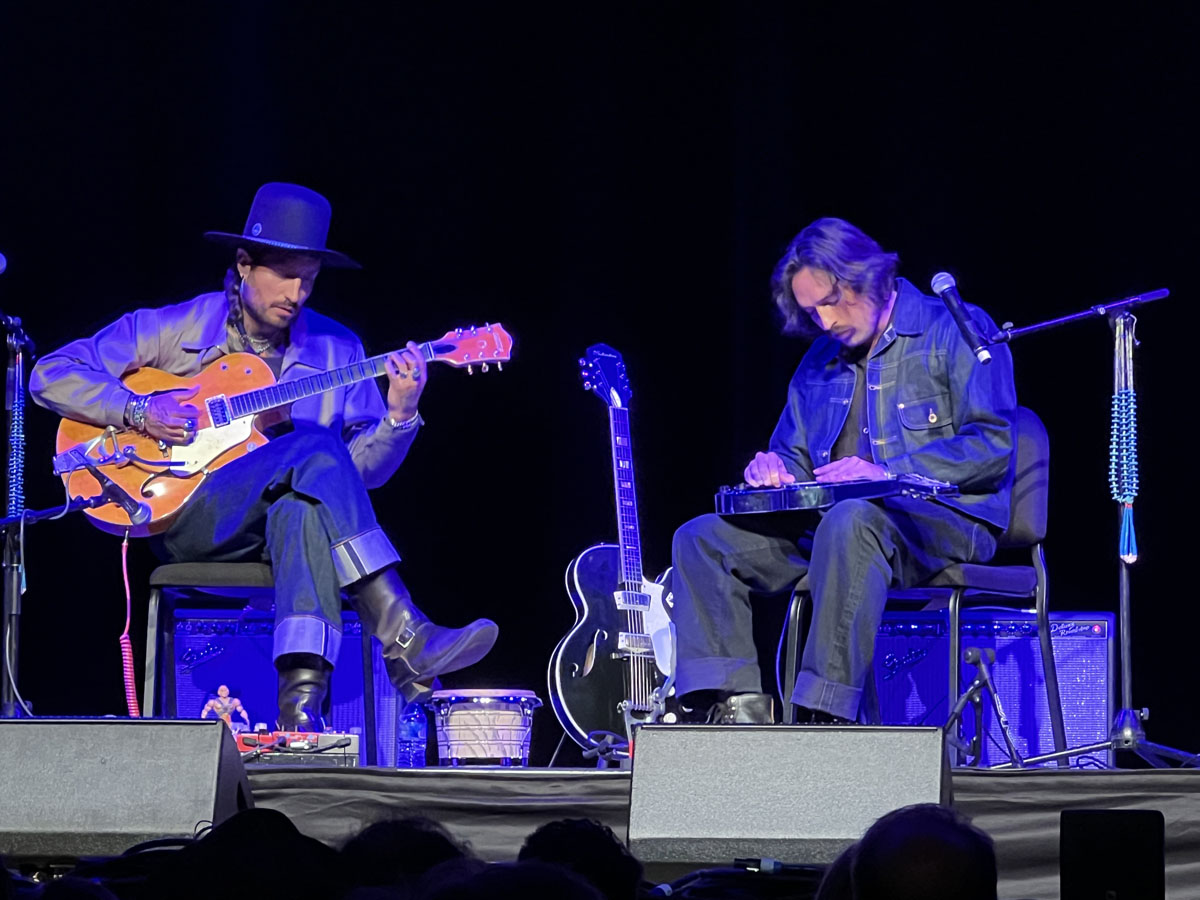
Hermanos Gutierez Roger Eno at Big Ears Festival Pic: J. Diliberto
But also, the ensemble was under-rehearsed and although they were mostly playing whole notes, they needed to have that in sync. Eno stopped the performance a couple of times to get them on the same page. Nevertheless, Eno’s compositions took on an even more fragile and melancholy tone live than on his latest record, The Skies, They Shift Like Chords (Deutsche Grammophon.) Finally, in true Roger Eno form, he ended the performance with a rollicking rendition of “Ac-Cent-Tchu-Ate the Positive.” Go figure.
One of the surprise finds at the festival was Hermanos Gutiérrez, the duo of Ecuadorian-Swiss brothers Alejandro Gutiérrez and Estevan Gutiérrez. I first heard of them shortly before the festival, but they packed the large Tennessee Theater. Their sound is born of the Southwest, Sergio Leone’s spaghetti western scores, and a bit of Hawaiian music, the latter of which came out when one of them switched to lap steel guitar. Their sound is laid back, but atmospheric, forged in tremolo torque and deep reverb.
There were a lot of aging jazz artists at the festival. Besides Henry Threadgill (80), there was also Charles Lloyd (86), Herbie Hancock (83) and Dave Holland (77). There was the morbid thought that this might be the last time to see any of them. I didn’t see Hancock’s set, but I caught all of Lloyd’s and Holland’s and two sets with Threadgill and a third with proxies.

Jason Moran, Charles Lloyd, Larry Grenadier and Eric Harland Big Ears Festival Pic: Jeff Towne
Charles Lloyd was a bit tepid, despite fronting a great group with pianist Jason Moran, bassist Larry Grenadier and drummer Eric Harland. They played through Lloyd’s latest album, The Sky Will Still Be There Tomorrow (Blue Note.) Lloyd switched between meditative flute pieces on alto flute and more energized tracks on tenor sax. He never seemed to catch up with the energy.
Dave Holland, on the other hand, neither looks nor sounds like he’s lost a bit of energy. And he needed it with a band consisting of pianist Kris Davis, alto saxophonist Jaleel Shaw, and drummer Nasheet Waits. Holland’s opening bass solo revealed why he is so revered. His sound is deep and dark, like he’s drawing from a well of dark, rich chocolate and putting it on a Formula 1 racer. It is the definition of tone. And then it was off as the band launched into a set of propulsive drive. Watts is a dynamic drummer and Kris Davis is a cyclone on piano, alternating between melodic lightning and Cecil Taylor-esque clusters. When she switched to a Fender Rhodes piano, you could hear echoes of Holland’s time with Miles Davis. Even when the compositions got knottier, the passion in the playing was evident.

Fred Frith at the Big Ears Festival 2024 Pic: Jeff Towne
Improvisation is everywhere at Big Ears. Bassist Christian McBride and pianist Brad Mehldau gave a performance that was full of virtuoso flights and intuitive interplay. Fred Frith also uncorked a freewheeling set at the Bijou theatre with a band that included Jason Hoopes (electric bass), Jordan Glenn (drums), and special guest trumpeter Susana Santos Silva, who was fantastic. There was also Heike Liss doing visuals projected on a rear screen. Frith did his guitar mutilation approach, playing it with brushes and other implements, and distortion. He even played it as a regular guitar drenched in reverb. The rhythm section kept the whole thing locked in, and Silva tossed out sputters, between the valve effects and some beautiful straight playing and a clarion call solo that charged the room. It occasionally coalesced around the feel of electric Miles Davis.
I felt like there wasn’t as much conceptual music as there had been in the past at Big Ears, but Laurie Anderson and Sleepy Time Gorilla Museum made up for it. Laurie Anderson may have been the most beloved performer at Big Ears. She is simply adored and she deserves it. She delivered a retrospective performance drawing on music from her debut, Big Science, and the follow-up, Mr. Heartbreak. She made good use of her back-up band, the jazz ensemble Sexmob, and rearranged many songs to take advantage of their virtuoso ability and ensemble cohesion. Their opening song was an epic rendition of “From the Air,” in which the closing line, “This is the time and this is the record of the time” was repeated and returned to, turning into a warning mantra. She injected a few references to AI, updating tech imagery that was first recorded when the answering machine was state of the art. There was a poignant tribute to her late-husband Lou Reed on “Junior Dad,” a song he recorded with Metallica. Laurie played some sylvan electric violin under a spoken word segment featuring Reed’s voice. Then the band launched into the metal chords of the song which sounded less like “Junior Dad” and more like “Sweet Jane.”
Anderson also got the audience to scream for ten-seconds, inspired by Yoko Ono’s three-minute blood-curdling scream when asked what she thought about the 2016 Presidential election. For an encore, Anderson led the audience in tai-chi moves. It was magical. She is loved. And we were blessed.

Sleepytime Gorilla Museum, performing at the Big Ears festival, 2024 Pic: Jeff Towne
At the opposite conceptual end was Sleepytime Gorilla Museum. I only caught part of their set, but it was like a meeting of The Dandy Warhols and Magma. Dressed in crazy costumes and playing some homemade instruments including an adapted Blaster Beam, metal sinks, and a bicycle wheel, they were funny and immersively aggressive, playing to the “hill people in the surrounding mountains of Knoxville.”
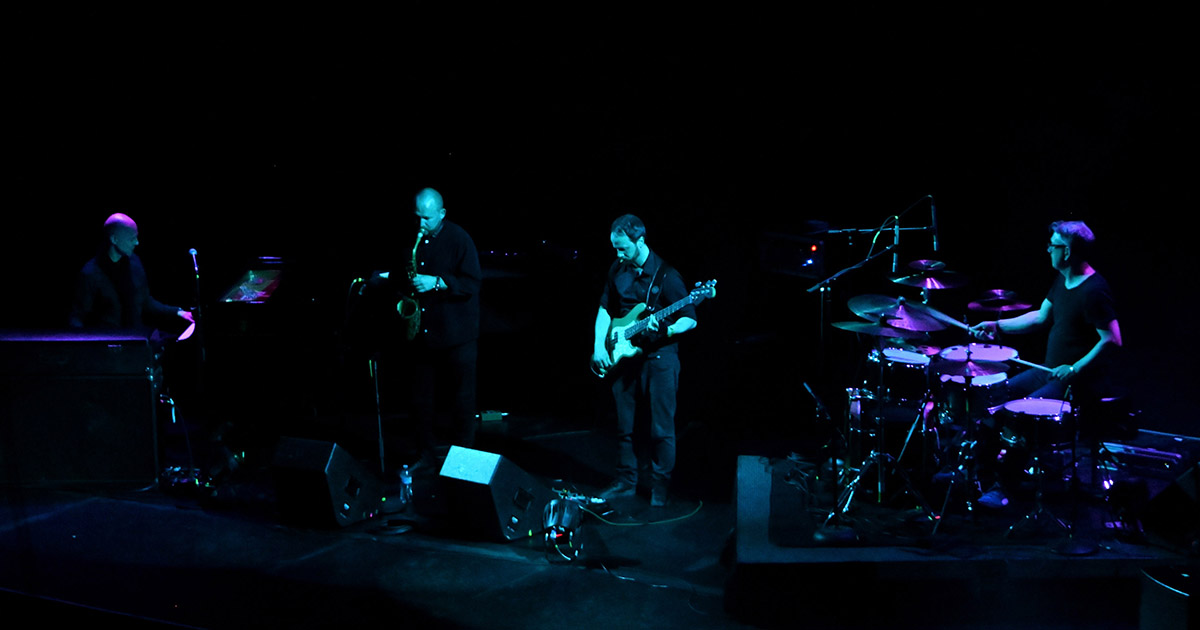
Nik Bärtsch’s Ronin: Nik Bärtsch, Sha, Jeremias Keller, Kaspar Ra at Big Ears Festival; Pic: Jeff Towne
One of the most uplifting concerts of the festival was Nik Bärtsch’s Ronin. The Swiss ensemble, led by pianist Bärtsch, plays tight, composed music. Solos are all in service of the main theme, never rising up to anyone shredding in a John Coltrane sense, although there was certainly that opportunity for the saxophonist, Sha. The music is driving, with sudden shifts of rhythm and dynamics. Bärtsch is a percussive pianist and at times might seem funky if he was playing electric piano or clavinet. Bathed in stage smoke, Ronin seemed like high priests of minimalism and the mystic.
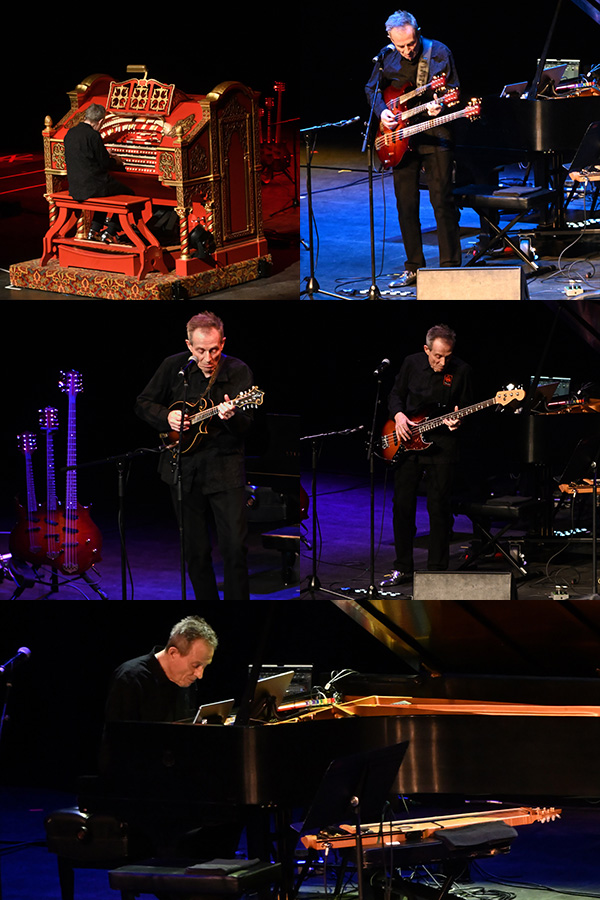
John Paul Jones at the Big Ears Festival, 2024; Pic: Jeff Towne
The surprise of the festival may have been John Paul Jones, the former bassist and utility man for Led Zeppelin. Performing solo in the Tennessee Theater, his set opened with the theater’s pipe organ played by an unseen hand, until the ornate organ rose up out of the orchestra pit, Jones at the multiple keyboards, at which point he segued into the opening organ fugue of Led Zeppelin’s “Your Time Is Gonna Come.” The audience went bananas. Then, with many humorous interludes, Jones played a set of reimagined Led Zeppelin songs, and more. You got “When The Levee Breaks” on lap steel, “Going to California” on a triple-necked electric mandolin, and his bass line from “Ramble On” played solo, or as he said “isolated,” which “gets rid of the unimportant stuff like guitars, drums and singing.”
There wasn’t as much world music at the festival as in years past, but The Silk Road Ensemble, originally created by cellist Yo-Yo Ma and now completely new, led by Rhiannon Giddens, picked up the slack. With a global cast of musicians, they weaved through themes eastern and western. Gidden’s southern folk roots were definitely in evidence with her railroad songs. One of the most powerful, yet stoic performers was native singer and lap steel guitarist Pure Fe. She launched a country-like vocal on “Have You Seen My Man” and was joined in harmony, then lead, by Giddens, who sashayed as she sang, gyrating her hips.
This is definitely the most sensual and raucous version of Silk Road ever. I did think Giddens’s comment about not having to fill Yo-Yo Ma’s shoes because she doesn’t wear shoes was a bit dismissive. But she did fill shoes, they were just different.
In one of those Big Ears accidents, I happened to be walking from one show to the next when I walked by the Rega Square venue and saw a guitar-lead trio through the glass walls. I stepped in and caught most of Jakob Bro’s set. I’ve always wanted to like Bro, but felt his ECM albums were too restrained and polite. Live, he’s a bit more aggressive, doing live looping and using a lot of distortion. But his playing seemed withdrawn and hesitant, despite storming rhythms from drummer Brian Blade.
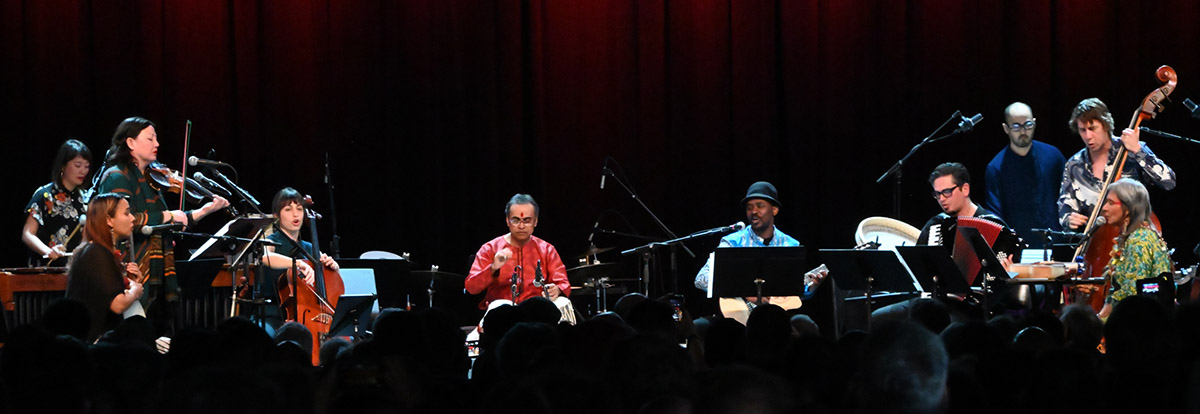
Silk Road Ensemble, Live at Big Ears 2024; pic Jeff Towne
I ended the festival with two disparate acts Sunday night. André 3000 and Medeski-Russo-Ribot. André 3000 was the buzz of the festival, having released his ambient new age jazz album, New Blue Sun, a hard left turn for the Outkast rapper. He played five separately-ticketed shows at the festival, and I caught the last one at The Point, a converted church. It was a captivating performance of completely free playing as André 3000 performed on various flutes, including an Indonesian suling, Native American flute, and ocarina, as well as small percussion and xylophone. He was joined by close collaborator, percussionist Carlos Niño, guitarist Nate Mercereau, keyboardist Surya Botofasina, and percussionist Deantoni Parks with a special guest appearance by Shabaka on small flutes. There was also a percussionist whose name I didn’t catch.
The music was a swirl. After an off-stage intro playing the church’s organ, Botofasina sat in a bank of keyboards playing barely-there chords and synthesizer colors. Mercereau’s guitar never sounded like a guitar, but created ambient effects and for the most part, the percussionists played small, creating a jungle of ambient noise to accompany the jungle effects of André 3000. It often took me back to The Art Ensemble of Chicago and albums like People in Sorrow and Miles Davis tracks like “He Loved Him Madly.” It never settled into a melody or rhythm, just a wash of sound evoking a natural landscape,
Partway through, André 3000 invited the audience to add their own noises. I immediately wished he hadn’t done that, especially when the otherwise nice gentleman next to me let out a mad scientist scream. While the effect of the New Blue Sun album is soothing, this ensemble reached a roaring crescendo toward the end that was a complete, free jazz storm.
This was a remarkable contrast to my last show, with organist John Medeski, drummer Joe Russo and guitarist Marc Ribot. Their set at the SRO Mill & Mine was a storm of jam-band improvisation set to overdrive. Medeski kept up an organ pulse and seemed to be leading the ensemble into different movements, while Russo kept up a driving groove, while still playing fairly free. Ribot alternated between shredding distortion leads and deep noise experiments. It was an exhilarating ride from three virtuoso musicians and improvisors.
I didn’t catch everything I wanted to at Big Ears. I missed Herbie Hancock, Kronos Quartet, Colleen and many more. And like all Big Ears Festivals, I didn’t know what I’d missed. But the one thing I said in my preview article that remained true was you have to forget FOMO at the Big Ears Festival.
–John Diliberto
JEFF TOWNE’S PATH THROUGH BIG EARS FESTIVAL 2024
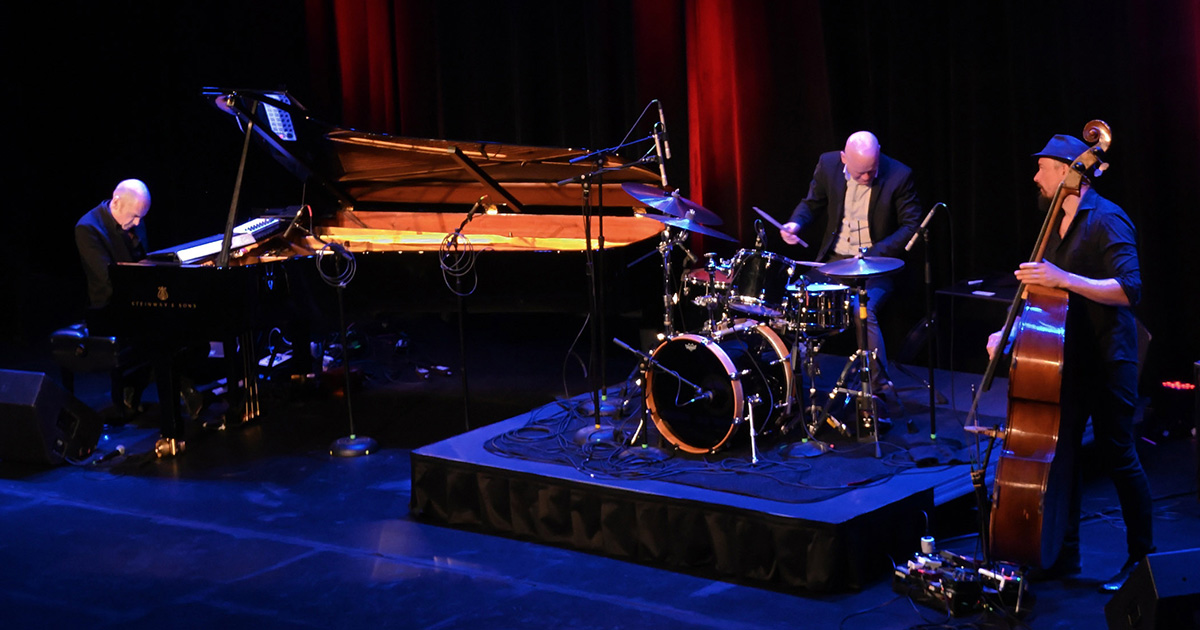
Tord Gustavsen Trio, Live at Big Ears 2024; pic Jeff Towne
John and I sometimes ended up at the same concerts, but over the course of four days, I managed to catch a few performances that he didn’t. While John started with Henry Threadgill’s Very Very Circus, I began my experience with the stately chamber jazz of the Tord Gustavsen Trio. Although it started with a restrained, almost classical tone, replicating the refined feel of their ECM recordings, as the set progressed, the energy got a bit stormy at times. The overall aesthetic was one of restraint, with plenty of space between notes. But then, ethereal sounds would emerge, often from mysterious sources. They appeared to be an acoustic trio of grand piano, upright bass and a small drum kit, but phantom harmonies floated on top of the acoustic sounds. Bassist Steinar Raknes occasionally knelt-down and whistled into his instrument’s microphone, which he had routed through multiple guitar effects pedals. At other times, he’d play the bass more conventionally, but employ echo, distortion and harmonizer pedals to add new layers of sound, at one point simulating a credible heavy-metal guitar solo.
Gustavsen mostly played the grand piano, but he had a couple of small electronic devices stacked on top, one of which was a ROLI Seaboard, a small touch-sensitive controller that allows complex expression usually not possible on a keyboard. He used it to add otherworldly, swooping, sliding solos over the more conventional foundation. Although the concert started with a sedate, polite sound, they eventually traveled through a thrilling range of energies.
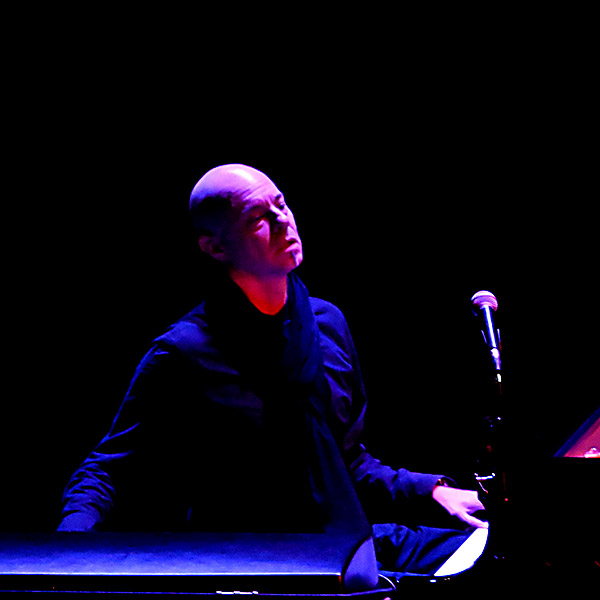
Nik Bärtsch, at the Big Ears festival, 2024; pic Jeff Towne
The typical Big Ears overlap created some hard decisions for the rest of the evening. I usually try to stay for entire performances, but I got a little greedy this time, catching a couple of tunes by Kurt Vile and the Violators before dashing back to hear some of Nik Bärtsch’s Ronin. They were so good that it was very hard to leave a little early to get situated for Charles Lloyd, a few blocks away. I liked Lloyd’s performance more than John did: there’s something magical about his warm, round tone on both saxophone and flute. He might not have been pushing any boundaries, but he was making lovely music!
Lovely is not a term you’d use for the set by bassist Trevor Dunn’s Trio Convulsant, avec Folie a Quatre. This performance featured an almost non-stop flurry of notes, in time signatures that would make most music students’ heads explode. While there’s ample room for soloing and improvisation, most of the music is written-out, in dense clusters of dissonance and tension. Virtuosic playing from everyone provided plenty of fireworks, but this was not a performance for the faint-of-heart!
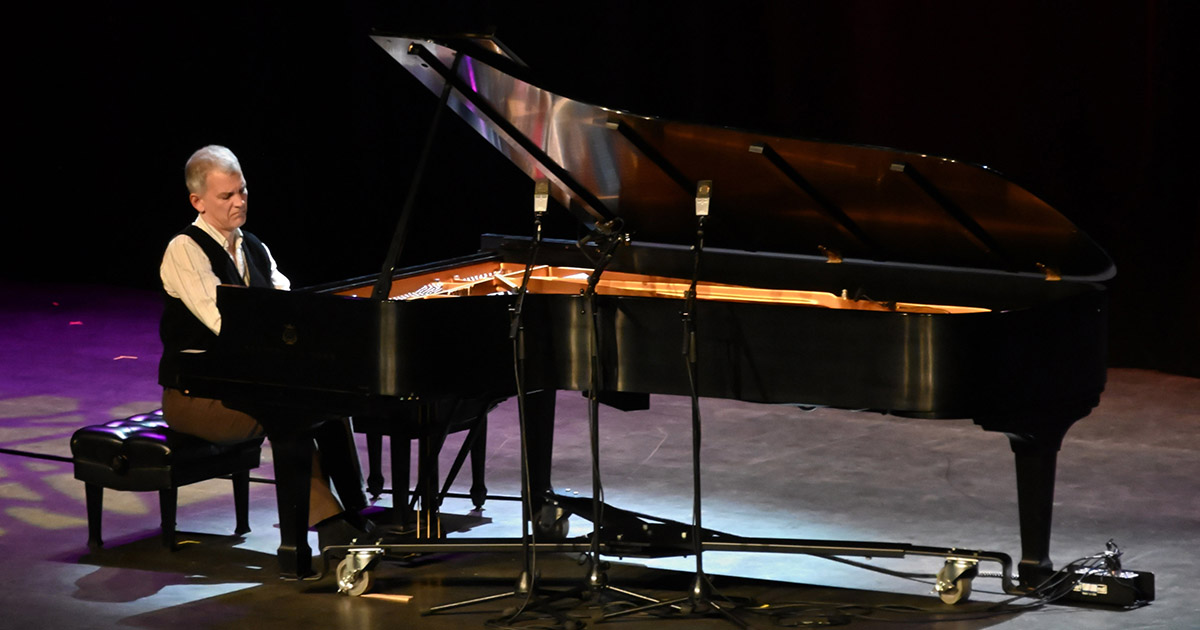
Brad Meldhau, at the Big Ears festival, 2024; pic Jeff Towne
I only managed to catch a few tunes by pianist Brad Mehldau, but those were unsurprisingly pristine, sensitive renditions of original tunes, as well as covers of songs from pop artists such as Elliot Smith and Jimi Hendrix.
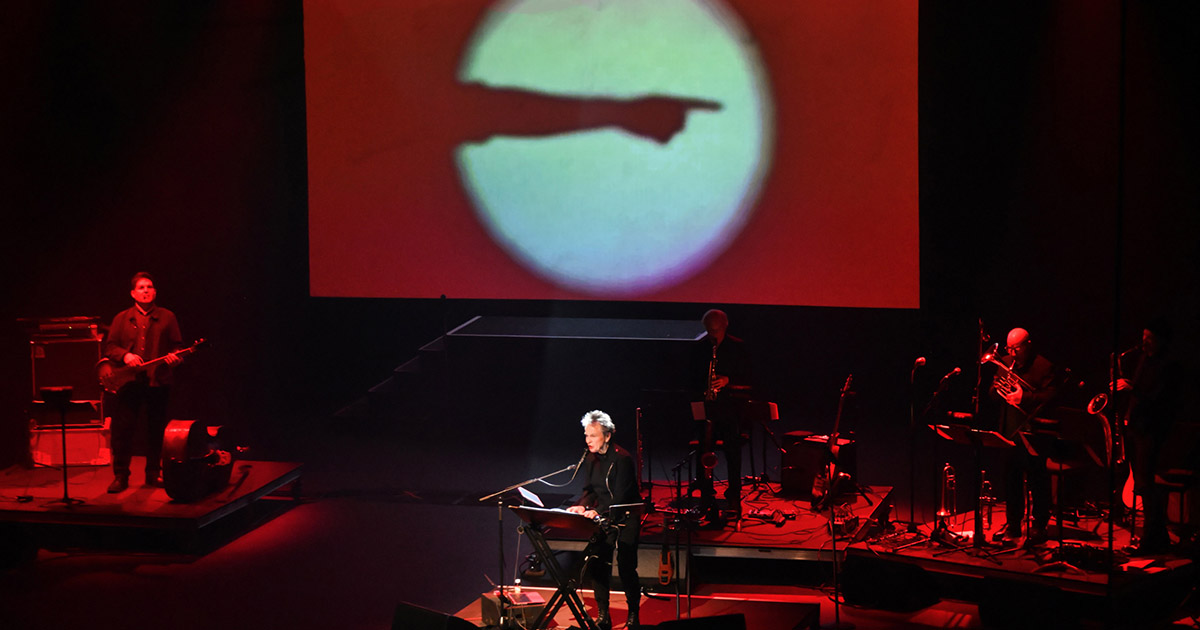
Laurie Anderson, at the Big Ears festival 2024; pic by Jeff Towne
The Laurie Anderson concert was a highlight for me, which was not really a surprise, but it was very satisfying to hear so many old favorites, excellently interpreted by the band Sexmob.
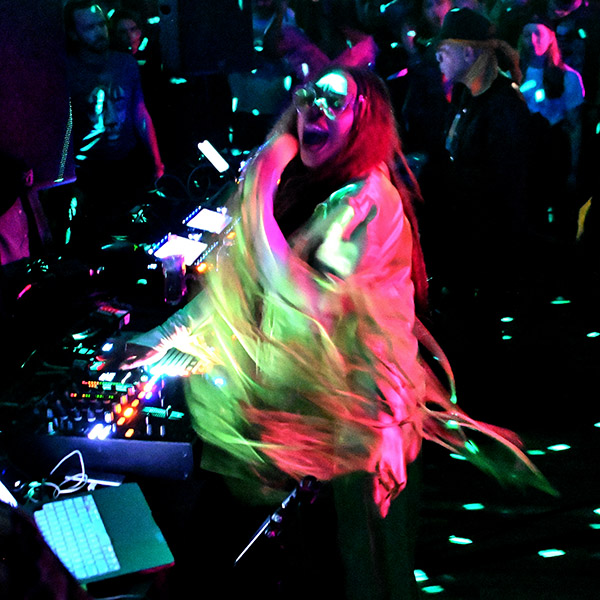
Suzi Analog, at the Big Ears Festival, 2024; pic Jeff Towne
There was another level of energy up at the Mill and Mine, where DJ consoles had been set-up in the middle of the floor. I’d gone to see Techno legend Carl Craig, but I’m glad I got there a bit early, and caught some of the high-energy spinning by Suzi Analog. I’m not up on all the sub-genres of electronic dance music, there seem to be new categories every 15 minutes or so. I’d never heard anything quite like it: a nonstop barrage of stuttering drums, at somewhere around infinity BPM. Add-in some ecstatic MC vocalizations, and the room was vibrating so hard that I worried about the structural integrity of the building.
But I was there to see Carl Craig, who is one of the founders of the very influential Detroit Techno scene in the late 1980s, into the 1990s. Craig has composed lots of original music, but this was a DJ set, segueing seamlessly out of Suzi Analog’s storm of shifting rhythms. In contrast, Craig’s set featured a rock-solid four-on-the-floor beat, that remained constant throughout. But over that propulsive pattern, Craig floated spacey analog synth melodies, Jimi Hendrix guitar solos, spoken word, and almost anything else you can think of. The dim lighting (other than a large mirror ball) underscored that this music is about dancing, not about flashy scratching. And the crowd did keep dancing, but there was also enough musical complexity to make it enjoyable to sit back and just listen, as I ended up doing after my feet started complaining.
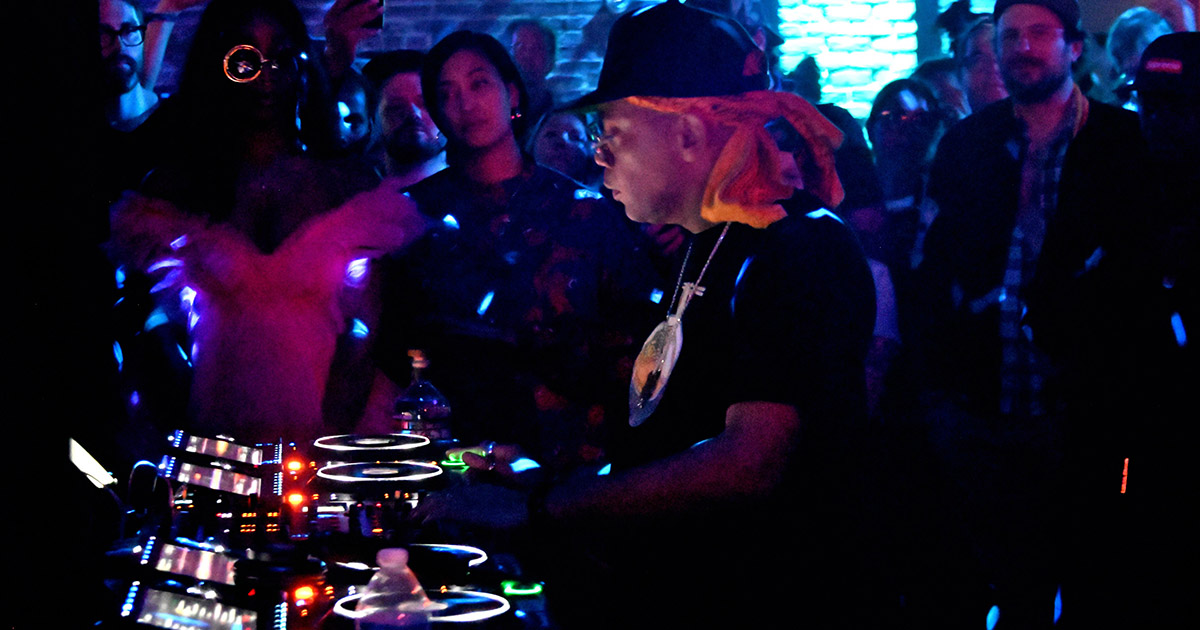
Carl Craig, at the Big Ears festival, 2024; pic Jeff Towne
Both of these sets were part of an extensive array of performances and discussions, under the umbrella of “Blacktronica,” a stylistic category being researched, and promoted, by musician and academic, King Britt. Electronic music is too often thought of as being made by white European dudes, and Britt is enthusiastically promoting the extensive contributions of black artists, past and present. I’d hoped to see more of the performances presented under this umbrella, but scheduling at this festival is always frustrating. I hope that Blacktronica will have a consistent presence at future festivals.
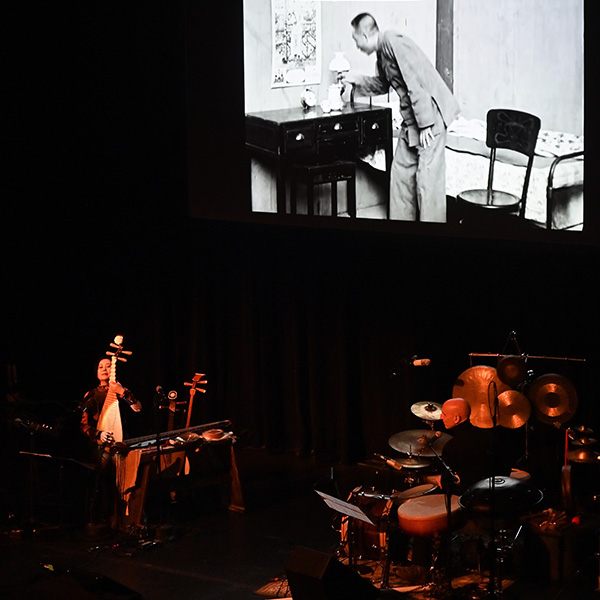
Min Xiao-Fen and River Guerguerian, at the Big Ears festival, 2024; pic Jeff Towne
Running from venue to venue caused me to view only part of a thoroughly charming performance by Pipa master Min Xiao-Fen, accompanied by percussionist River Guerguerian. Those two musicians could surely have made some fascinating music on their own, but for this show, they were creating a live score to Chinese silent movies from the 1920s.
The movies themselves were pretty silly: pure slapstick with extensive mugging for the camera. But employing the twangy pipa, and comedic vocalizations, Xiao-Fen brought the movies to life, aided by Guerguerian’s vast array of percussion instruments and noisemakers. The two had a great musical telepathy, and succeeded in elevating the films.
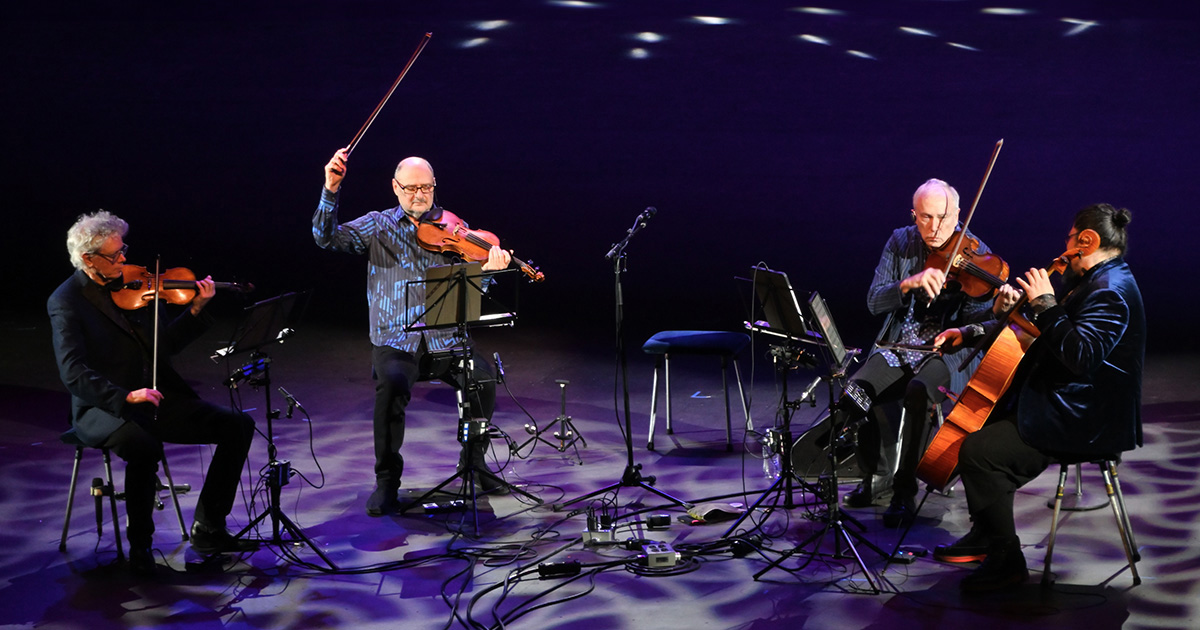
Kronos Quartet, at the Big Ears festival, 2024; pic Jeff Towne
The mood was a little more serious at the Kronos Quartet concert, but not overly so. It seems ridiculous to say that their performance was excellent: of course it was. As Laurie Anderson had done the night before, Kronos surveyed many of their classic pieces, without it being merely a greatest-hits collection. They did perform crowd-favorite works by Steve Reich, Philip Glass, and, yes, even Jimi Hendrix. After their (excellent) rendition of “Purple Haze” founder Michael Harrington introduced throat-singer Tanya Tagaq, and joked that if they’d been working with her at the time they recorded it, perhaps they would have included her on Purple Haze. This made me wonder why they didn’t give it a try! Seemed like a missed opportunity. Tagaq performed a couple of powerful pieces with the string quartet, including her intense original song “Colonizer.” Earlier, vocalist Brian Carpenter from the Ghost Train Orchestra joined the quartet for a piece by Moondog.
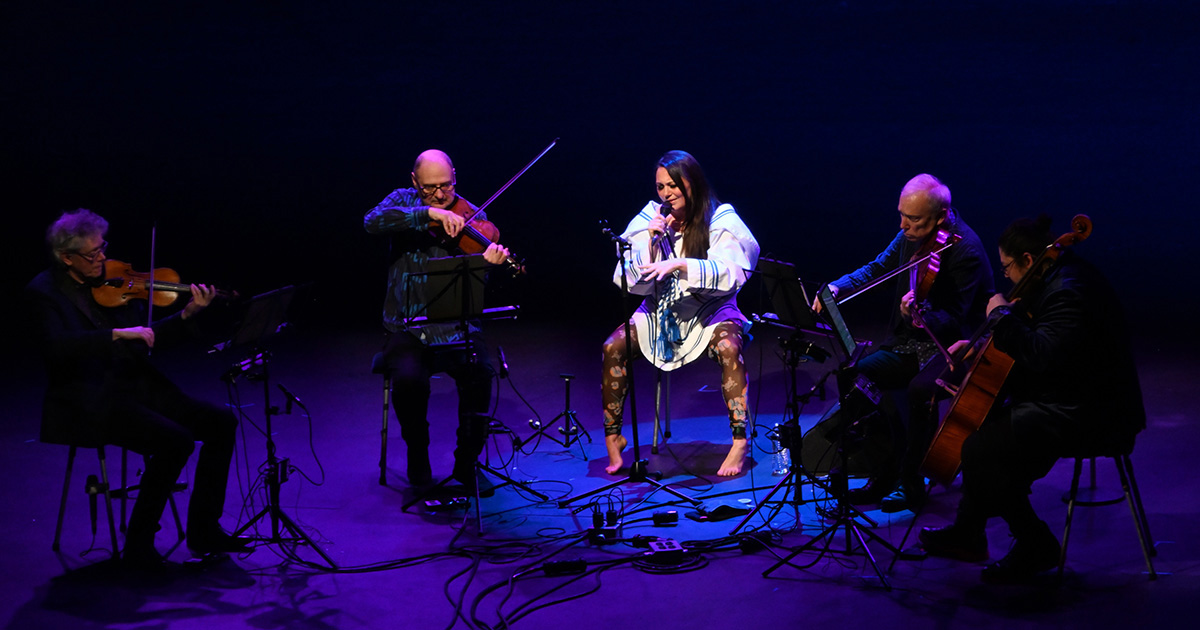
Kronos Quartet, with Tanya Tagaq, at the Big Ears festival, 2024; pic Jeff Towne
This was the only Big Ears performance I’d ever seen that included an intermission, breaking the program into two hour-long sets. Even so, the performance flew by, and was made even more poignant by the announcement that violinist John Sherba and violist Hank Dutt would be retiring from the ensemble in June. Each has been playing with Kronos for over 45 years, so retirement is quite understandable. But Kronos will go on. Harrington announced two new members: violinist Gabriela Díaz and violist Ayane Kozasa. But this was surely one of the last performances by the classic ensemble (at least 3/4 of it: the occupant of the cello chair has changed a few times over the years.)
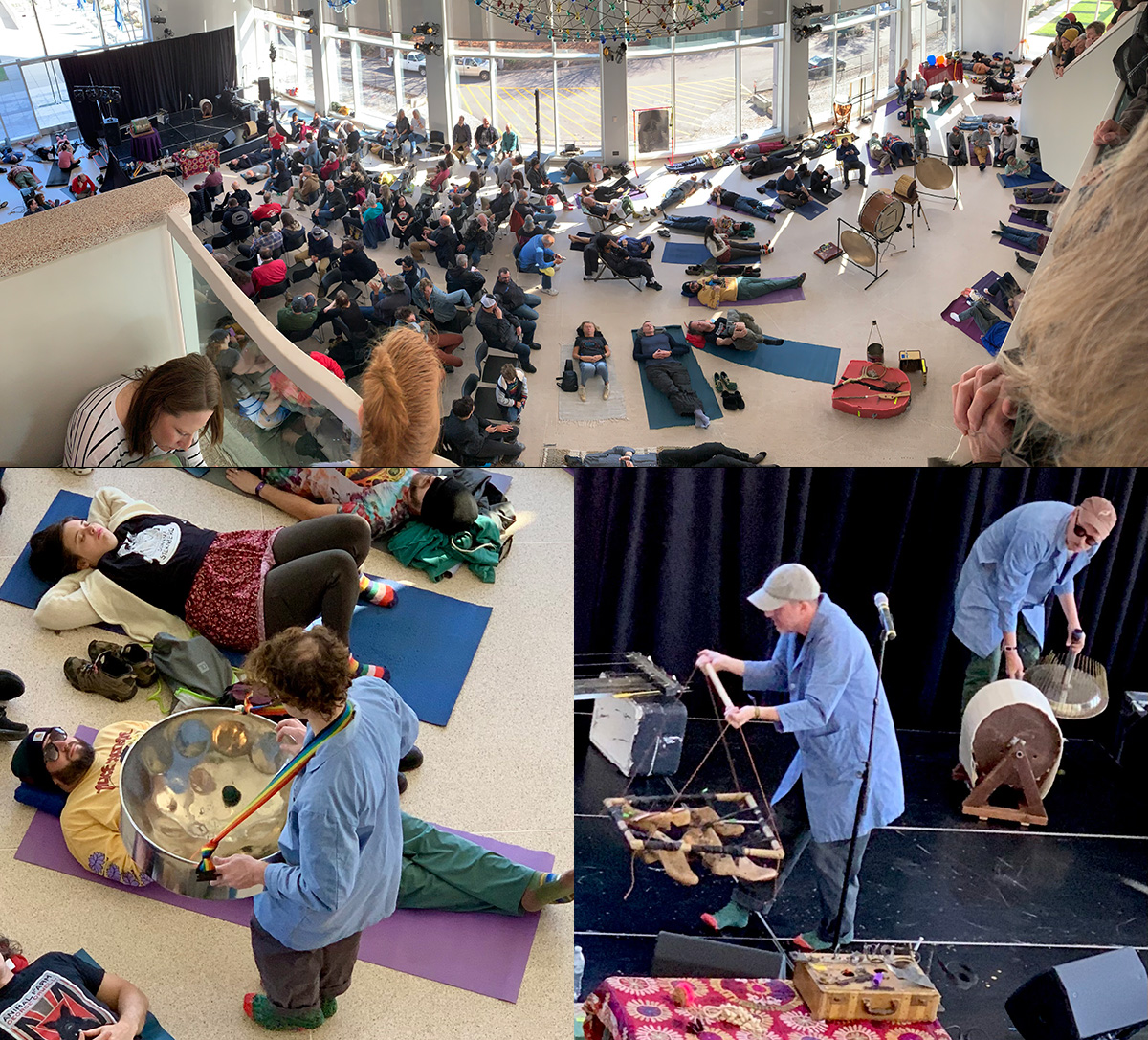
“Wolle-Sonic Massage” led by Kenny Wollesen, at the Big Ears Festival, 2024; pic Jeff Towne
Sunday morning started with a “Wolle-Sonic Massage” led by Kenny Wollesen, and a cast of several lab-coat-wearing assistants. I was unable to fully experience the sonic therapy, because the space had filled-up early, so I was banished to a balcony, observing the process, rather than being immersed in it. Even so, I could easily imagine what the experience would be like. The audience was encouraged to lay on the floor, or sit in chairs, and keep their eyes closed, as the members of the group quietly tip-toed around the room, making subtle sounds with a wide array of “instruments.” Some were identifiable, like gongs, steel drums, and variations on whistles and noisemakers. But many of the the other implements were a bit more homemade and cyber-punk, many featuring large cranks that would rotate blades through the air, making subtle whooshing sounds. One member was carrying a square frame with a dozen wooden shoe-forms dangling from it, and would gently lower the wooden feet to the floor, near a meditating audience member. I’m not sure if that would be soothing or alarming, but nobody jumped-up in fear. This whole thing initially seemed a little frivolous to me, but I quickly became jealous of those who had made it to the floor, and were immersed in these odd sound effects. I can’t testify to whether it was relaxing or not, but, if they do it next year, I’ll be getting there earlier!
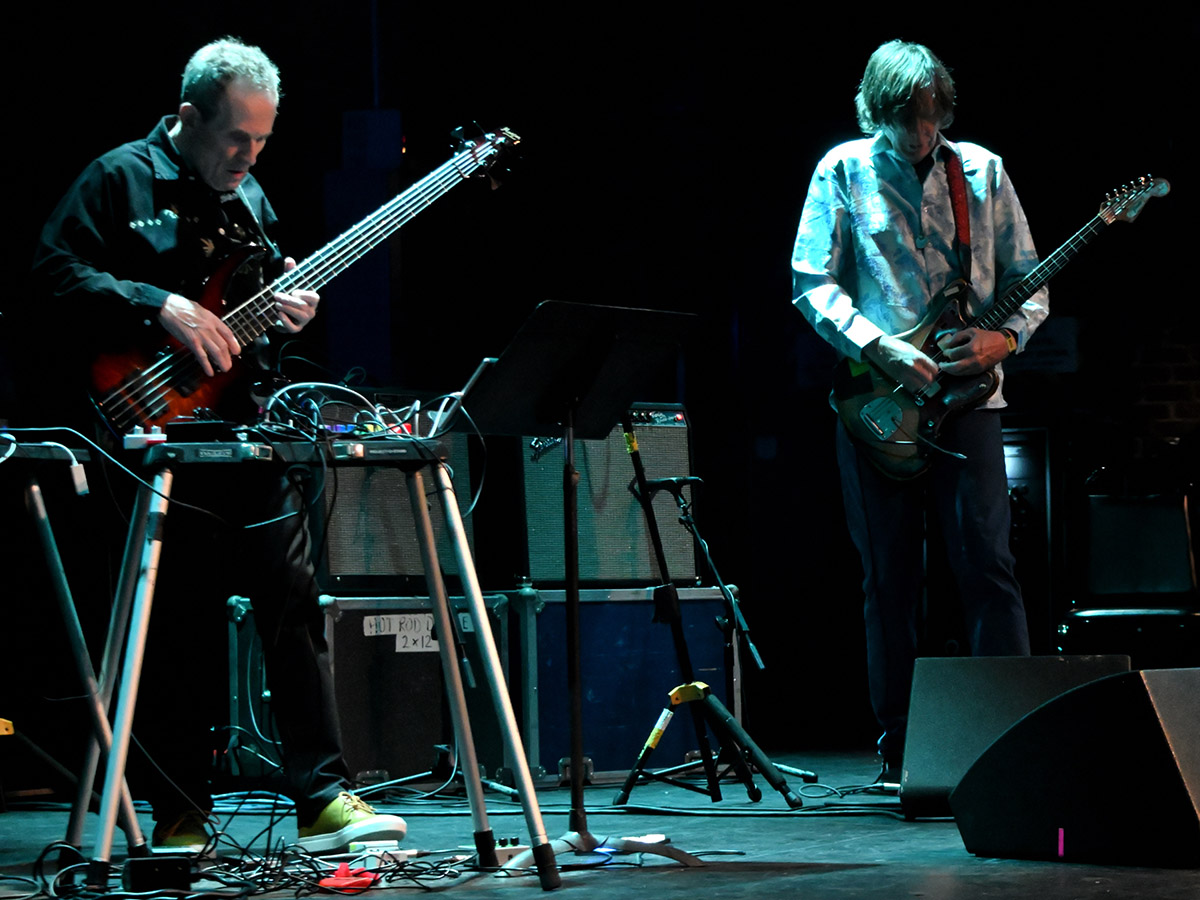
John Paul Jones and Thurston Moore, at the Big Ears festival, 2024; pic Jeff Towne
There was understandably a lot of buzz about the collaboration between John Paul Jones and Thurston Moore. After his charmingly quirky solo set, and a melodic duet with cellist Anssi Kaettunun, as “Sons of Chipotle,” it seemed like Jones was on a roll. But I don’t think anyone anticipated the level of interest: I’ve never seen lines this long at Big Ears. It didn’t help that the show was running late, but the larger problem was that it seemed like everyone at the festival had showed up for this one performance. Anticipation was high: would they do some Led Zeppelin covers? Riff on Sonic Youth hits? …nope.
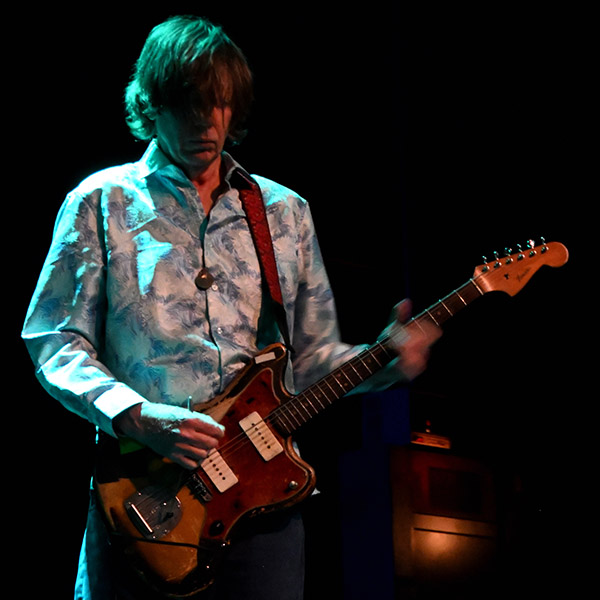
Thurston Moore, at the Big Ears festival, 2024; pic Jeff Towne
They came out of the gate with a massive wall of distorted noise, and kept the intensity at full-blast the whole time. Even after Jones moved from electric bass to the piano, the dissonance remained, as he delivered clotted clusters of notes. Moore kept the storm of distorted guitar coming, sticking screwdrivers and drumsticks in his guitar’s strings, and giving the whammy-bar a workout that surely voided its warrantee.
To be fair, it was occasionally interesting noise, but it was so unrelenting, so extreme, that it ultimately felt self-indulgent. The audience seemed to agree and voted with their feet: after the massive lines to get in, by the second half of the 90-minute show, the venue was perhaps a third full.
After that, I was on my way to another show when I noticed that Cyro Baptista was about to start playing at a venue along my way. I figured I’d listen to a song or two, as a fun antidote to the doomy noise-fest I’d just left. And it was fun, but, I was not prepared for how overwhelmingly awesome this set would be.
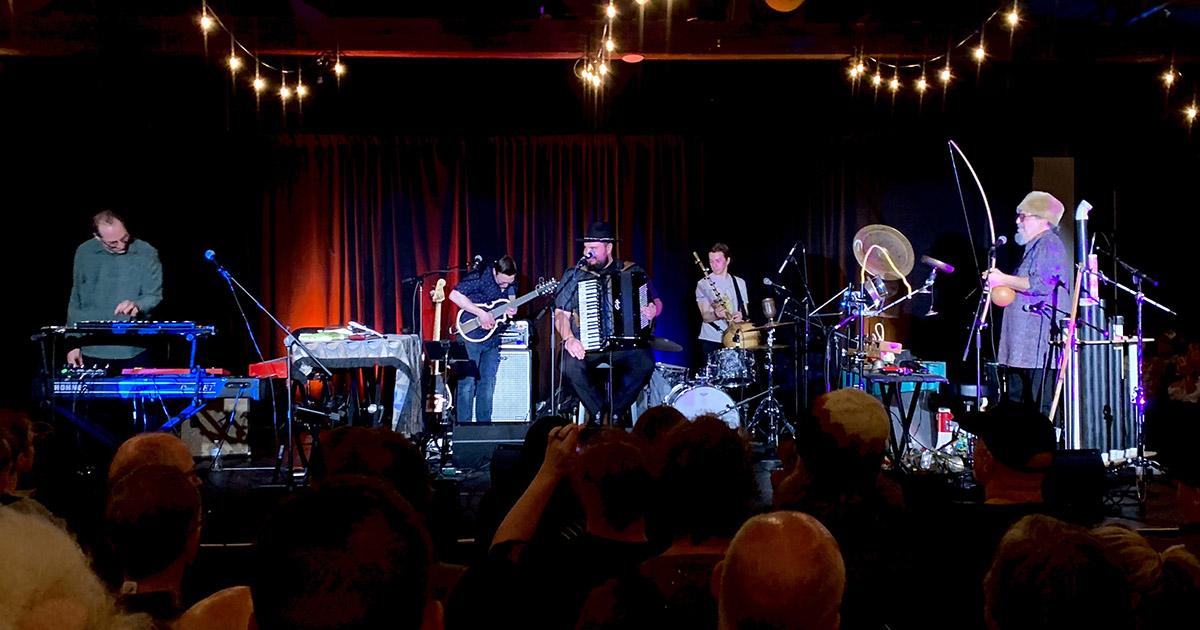
Cyro Baptista, and CHAMA, at the Big Ears festival, 2024; pic Jeff Towne
Legendary Brazilian percussionist Baptista has assembled a band he calls Chama, and they quickly proved to be prodigious players, on their main instruments, and seemingly, whatever you threw at them. Baptista was clowning around, playing homemade instruments and adding funny vocalizations, often processed though some basic stompboxes. But he was also laying down infectious grooves, backed-up by jaw-droppingly complex playing from the band. It was amusing, it was impressive, it was exactly the right way to close-out four days of amazing music!
–Jeff Towne
The End

The trombonist left Very Very Circus to sit in with Mary Halvorsen (I think) at the Tennessee Theatre. We were at Regas listening to the excellent finom set and figured we could pull the classic Big Ears move of waiting for the huge line to get in and arrive 15.minutes into the set with no issues. The late start blew that apart. We weren’t planning on staying long anyway. Agreed on dearth of world music this year. Need more of that next time. Cheers!
Julian Lage played a tremendous set at the Tennessee theatre with Kris Davis joining after the second tune. Playing instruments that looked against type for melodic, edgy Jazz, he is someone worth keeping tuned in on your music radar.
From these two, somewhat divergent paths and reviews, it “sounds” as though this year’s Big Ears was a bit of hit or miss – perhaps that’s what it’s about actually. Lot’s of interesting listening for sure, but also little bit of disappointing. I admit that I haven’t been as immersed in the Jazz and avant-garde circles as I once was but I sure would have liked to see and hear the “aging artists” such as Laurie Anderson, Dave Holland and Herbie Hancock – I am curious what he brought to the ears this year.
I was told that Herbie Hancock played an exciting, somewhat straight-ahead, jazz set with a great band.
I saw about 40 minutes of Herbie. I was excited to see him, as I had never seen him before. The energy was high, and it’s hard to believe that he is 83 as it doesn’t show, at all. The one thing I did discover, at both this show and at the Christian McBride electric band, is that I’m not really crazy about the kind of jazz, where the whole band plays for about 30 seconds to a minute, then one person, say the guitarist, takes a solo with minimal accompaniment, and then after that he/she sits there and twiddles their thumbs for an extended period, while other members of the band do likewise. Rinse and repeat. I get it some of the time, but it seemed to be happening a lot. I’d rather hear more ensemble playing, personally.